8M2 Global Studies
Section outline
-
Welcome to our MHJC Online 8M2 Global Studies 2020 course page. Please do not hesitate to contact me at mmartin@mhjc.school.nz if you have any questions about your classwork or homework. I look forward to working with you all in 2020. Ms Martin
-
Learning Intention:
We are learning to understand the significance of culture and identity of New Zealand
Success Criteria:
Identify the key aspects of culture and identity Describe key ideas about culture and identity and what makes us who we are Explain the importance of culture, and how each of us is unique Evaluate and reflect on how each of us has a different culture and 
This week we are focusing on NZ identity, Kiwiana.
Activities for the week in Google Classroom: Class code zimopuc
1. Game: Guess the Country
2. Countries and Symbols
3. Terms and Definitions
4. Beautiful New Zealand
Mind Map of What do you think of when you hear ‘New Zealand identity’ or ‘Kiwiana’(include symbols, words and pictures in the box below. You could also include titles of songs, poems or other literature). There are around 34 symbols, let's see how many you can identify in your mind map.
Deciding what makes Kiwiana depends a lot on who you are, your background culture and other influences that you have grown up with. For something to get the name Kiwiana it may have to meet the following requirement.
- Be recognised as familiar to many people across New Zealand
- Have stood the test of time (popular over time also)
- Hold a special memory or positive appeal
- It usually reflects a value/s or idea/s that many people hold
- They are quite often unique to that community/country
Achievement Objectives
L3
Understand how people view and use places differently.
Understand how people make decisions about access to and use of resources.
Understand how the movement of people affects cultural diversity and interaction in New Zealand.
-
Learning Intention:
We are learning to understand the significance of culture and identity of New Zealand
Success Criteria:
Identify the key aspects of culture and identity
Identify aspects of our Kiwi lifestyle that are unique to us as a culture
Identify kiwiana objectsDescribe key ideas about culture and identity and what makes us who we are
Describe Kiwiana objectsExplain the importance of culture, and how each of us is unique Evaluate and reflect on how each of us has a different culture Achievement Objectives
L3
Understand how people view and use places differently.
Understand how people make decisions about access to and use of resources.
Understand how the movement of people affects cultural diversity and interaction in New Zealand.

This week we are focusing on NZ identity, Kiwiana.Activities for the week in Google Classroom:
1. Code Breaker2. Countries and Symbols
3. National Identity
4. I'm a kiwi, but what's that?
-
Learning Intention:
We are learning to understand the significance of culture and identity of New Zealand
Success Criteria:
Identify the key aspects of culture and identity
Identify aspects of our Kiwi lifestyle that are unique to us as a culture
Identify Kiwiana objectsDescribe key ideas about culture and identity and what makes us who we are
Describe Kiwiana objects
Describe some of the events that have contributed to our unique Kiwi identityExplain the importance of culture, and how each of us is unique Evaluate and reflect on how each of us has a different culture Achievement Objectives
L3
Understand how people view and use places differently.
Understand how people make decisions about access to and use of resources.
Understand how the movement of people affects cultural diversity and interaction in New Zealand.
Activities for Week 4- DO NOW:
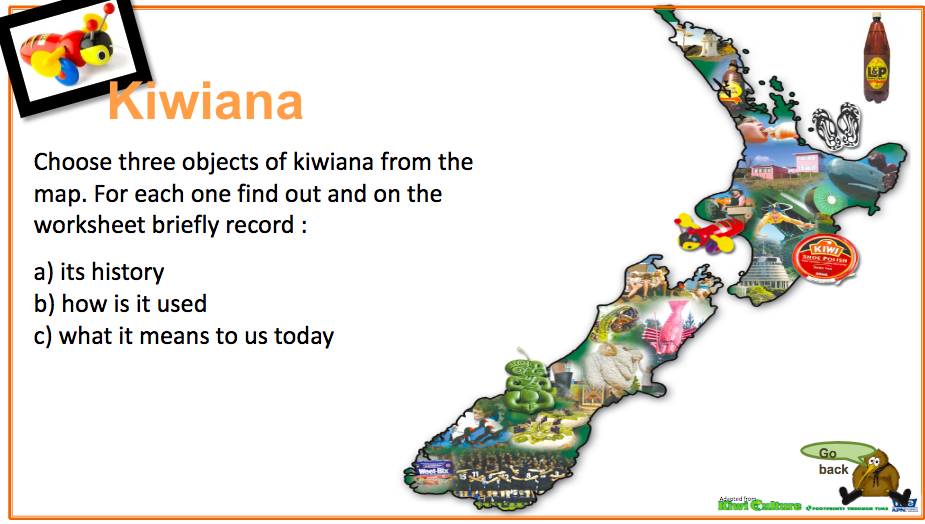
- 1. IMPORTANT KEY TERMS

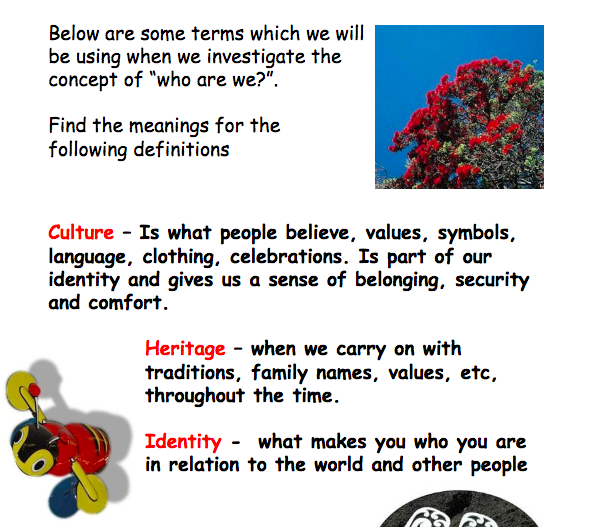
2. MATCH THE TERMS WITH THE RIGHT EXPLANATION

3. Understanding NZ see google classroom
4. What does it mean to be New Zealander?
5. Just Pretend, see google classroom
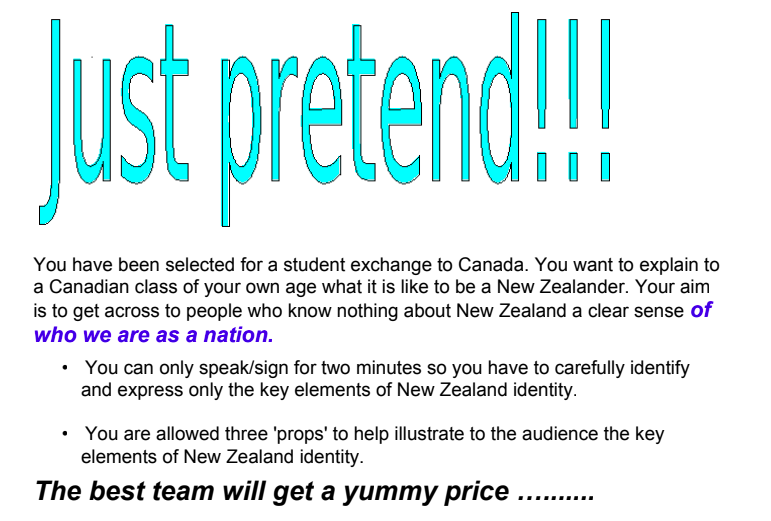
-
Learning Intention:
We are learning to understand the significance of culture and identity of New Zealand
Success Criteria:
Identify the key aspects of culture and identity
Identify aspects of our Kiwi lifestyle that are unique to us as a culture
Identify Kiwiana objectsDescribe key ideas about culture and identity and what makes us who we are
Describe Kiwiana objects
Describe some of the events that have contributed to our unique Kiwi identityExplain the importance of culture, and how each of us is unique Evaluate and reflect on how each of us has a different culture Achievement Objectives
L3
Understand how people view and use places differently.
Understand how people make decisions about access to and use of resources.
Understand how the movement of people affects cultural diversity and interaction in New Zealand.
Activities for Week 5
EXPLORE / TŪHURA learning intentions:
- We are EXPLORING taonga that are important to Aotearoa and explain why they are treasured.
- We are EXPLORING the significance of culture and identity of New Zealand
- We are EXPLORING National Identity of New Zealand
-
Achievement Objectives
L3
Understand how people view and use places differently.
Understand how people make decisions about access to and use of resources.
Understand how the movement of people affects cultural diversity and interaction in New Zealand.
Shared Assessment English/Global Studies Year 8
Hello Class. You are all studying the context of Treasure of New Zealand. We have examined some short texts that explore what treasures mean to different people .
You will create a poem / short text with at least 5 paragraphs or stanzas that explore an element of kiwiana in New Zealand. You have explored a number of poetic techniques in class, at least 5 different poetic techniques must be evident in your text.
Your assessment will examine short text/poetic writing and there needs to be poetic techniques evident in your short text. You will write a paragraph to identify and explain the poetic techniques you have included in your short text.
You will also provide a written commentary 2-3 paragraphs that firstly explain the element of kiwiana used in your short text as an aspect of New Zealand’s cultural identity, including the historical context and how the piece of kiwiana is perceived today. You will also develop a new piece of kiwiana either graphically or in words that demonstrates New Zealand’s welcoming of new cultures/people and how this is part of New Zealand’s identity.
You will submit your short text and poetic technique paragraph as well as your paragraphs about Kiwiana and National Identity
-
FOCUS / ARONGA learning intentions:
- We are FOCUSING on Kiwiana as an aspect of New Zealand’s cultural identity,
- We are FOCUSING on the historical context and how the piece of Kiwiana is perceived today
- We are FOCUSING on New Zealand’s welcoming identity of new cultures/people
-
This week we are going to work on our shared assessment task for English and Global Studies. For both subject areas you are presenting your short text about Kiwiana, and then you will have a specific piece of writing about poetic techniques for English and Kiwiana's link to National Identity for Global Studies. I am really looking forward to reading your texts.Success Criteria:
Identify Kiwiana and explain how it is used
Develop a new piece of Kiwiana suitable for Aotearoa in the 21st Century
Activities:
- Complete Kiwiana short text
- Identify the historical link of the Kiwiana to nationhood
- Explain how and why my new element of Kiwiana links to the identify and nationhood of Aotearoa
Homework:
Assessment Task 1
PLAN & DO / WHAKAMAHI learning intentions:
- We are PLANNING a new element of Kiwiana that demonstrates how New Zealand is viewed by different people
- We are creating a new piece of Kiwiana
-
Please upload your assessment in the link below
-
HOLA!!! So nice reconnecting with you all! Once a week we will have a video meeting through Google classroom, every Tuesday at 9:00 am. I will be emailing you the link and it will be done through Google Classroom.
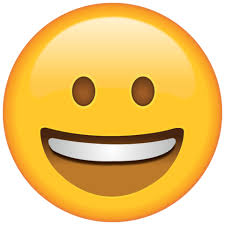
If you have managed your time well, you may have had a few polishing details to do, but the bulk of your work will be completed. Remember, this week you are uploading your assessment if you have not done it yet with all required tasks to both Global and English. You will need:
- Short Text (Poetic writing)
- Paragraphs about Kiwiana and National Identity
- Paragraphs about Poetic Language Techniques
We will be continuing our work on the Taonga of New Zealand by researching a specific geographical area of Aotearoa and creating a shared map (with 8M1) that details the many treasures we have in our beautiful country. We will be focusing on how people make decisions about access to and use of resources.
Success Criteria: I can/have...
Identify the resources of a geographical area
Research how the resource is perceived, used and protected
Explain how these ideas determine the decisions made about the resources
Learning Intention
We are EXPLORING NZ treasures in resources using geographic and mapping skills.
We are focusing on developing the use of map skills
Visible Learning
identifying continents and countries on a map and locate the local area through the development of map skills.
describe the location of the local area using simple geographical terms
Develop skills to use a map and Atlas effectively to locate features
Provide a 4 and 6 figure reference to locate places in a map
Activities
Google Classroom:
1. Understanding Geography -


Success Criteria: I can/have...
Identify the resources of a geographical area
Research how the resource is perceived, used and protected
Explain how these ideas determine the decisions made about the resources
Learning Intention
We are EXPLORING NZ treasures in resources using geographic and mapping skills.
We are focusing on developing the use of map skills
Visible Learning
identifying continents and countries on a map and locate the local area through the development of map skills.
describe the location of the local area using simple geographical terms
Develop skills to use a map and Atlas effectively to locate features
Provide a 4 and 6 figure reference to locate places in a map
ACTIVITIES IN GOOGLE CLASSROOM
Map symbols and grid references
-
Over the next few weeks, you will be working from home, please include your family and do the activities together if you are able. I know that your family are busy people, but working together in your bubble is a good way to keep connected - perhaps you can include elder family members too - a phone call to an aunt or a grandparent to share what you are learning could even surprise you with what your family already know!
Our new learning context is Wai and Kai not. Can you guess what this might be about? Wai is Māori for water and Kai is food - so how do these words go together? What might the not mean?

We are going to start investigating the consumer world and its impact on us, on our whanau, in our country and on our world.
Our goal will be to discover how we can be better consumers so we limit our impact on the environment.

This week we will look at needs and wants through different activities including drawing and playing cards. Have your needs and wants changed over the past 4 weeks?
Achievement Objectives:
L4: Understand how producers and consumers exercise their rights and meet their responsibilities.
L4: Understand how formal and informal groups make decisions that impact on communities.
Learning Intentions: I can/have...
- have a "big picture" of what the new topic for term 2 means
- understand the relationship between Rights and Responsibilities
- identify the difference between a want and a need.
- contribute ideas through different activities
Success criteria: I can/have...
- explain what the expectations for Term 2 are
- understand the importance of being responsible in order to respect people's rights
- give a definition of what Needs and Wants are
- make a collage showing needs and wants
Activities: (Google classroom)
- Read the Outline for Term 2
- Rights/Responsibilities
- Needs/Wants
-
EXPLORE / TŪHURA learning intentions:
- We are EXPLORING what are rights and responsibilities are and connecting these to our identity as consumers
- We are EXPLORING wants and needs and classifying these into essential and non-essential. We are collaborating with others to develop of shared understanding
Achievement Objectives:
Understand how producers and consumers exercise their rights and meet their responsibilities.
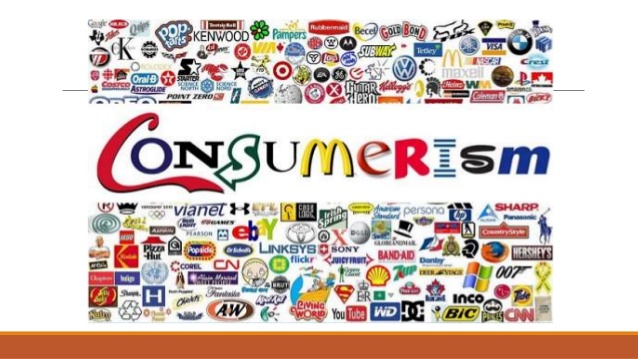
With our new context you will be working with your bubble, and by yourself investigating the consumer world and its impact on us, on our Whanau. Our goal will be how we can better consumers so we can limit the impact on our environment.
This week we will look at needs and wants through different activities including, drawing and playing cards.
Learning Intentions: We are learning to (WALT)...
- understand the relationship between Rights and Responsibilities
- identify the difference between a want and a need.
- contribute ideas through the different activities
Success Criteria: I can/have...
- understand the importance of being responsible in order to respect people rights
- give a definition of what is Needs and Wants
- make a collage showing wants and needs.
Rights/Responsibilities Google classroom
Why we buy?
-
Kia ora. Welcome to another week of distance learning. Have you been keeping up with the news? I guess we will know early in the week whether we this will be our last week working at a distance.
Achievement Objectives
Understand how producers and consumers exercise their rights and meet their responsibilities.
Learning outcomes:
Students will explore consumer protection in an authentic context.
Key concepts:
Rights
Responsibilities
Laws and regulations
Consumer protection
Success criteria: I can/have...
- Both consumers and retailers have rights and responsibilities
- Consumer protection laws and regulations cover goods and services purchased in New Zealand.
Activities (Google classroom):
- Why we buy
- Watch End of the line Video
- Consumer Rights (for early finishers)
Homework:
EXPLORE / TŪHURA learning intentions:
- We are EXPLORING what are rights and responsibilities are and connecting these to our identity as consumers
- We are EXPLORING wants and needs and classifying these into essential and non-essential. We are collaborating with others to develop of shared understanding
-
Global Studies Learning Intention
We are EXPLORING what are rights and responsibilities are and connecting these to our identity as consumers
We are EXPLORING wants and needs and classifying these into essential and non-essential. We are collaborating with others to develop of shared understanding
Global Success Criteria
Identifying key concepts
Observing the importance of being responsible in order to respect people rights
Identifying and describing the rights and responsibilities of consumers and producers
making connections between the process of trash disposal from our house to the ocean
Describe some environmental problems created by our consumer world
categorising impacts in the water due to our consumerism
describe the process of extraction through sale, use and disposal, all the stuff in our lives affects communities at home and abroad
Describe how the Consumer Guarantees Act and the Fair Trading Act protect the consumer
making connections between the process of trash disposal from our house to the ocean
Reflecting future economic and environmental strategies
ACHIEVEMENT OBJECTIVES:
Understand how producers and consumers exercise their rights and meet their responsibilities.
Our goal will be to discover how we can be better consumers so we limit our impact on the environment.
ACTIVITIES: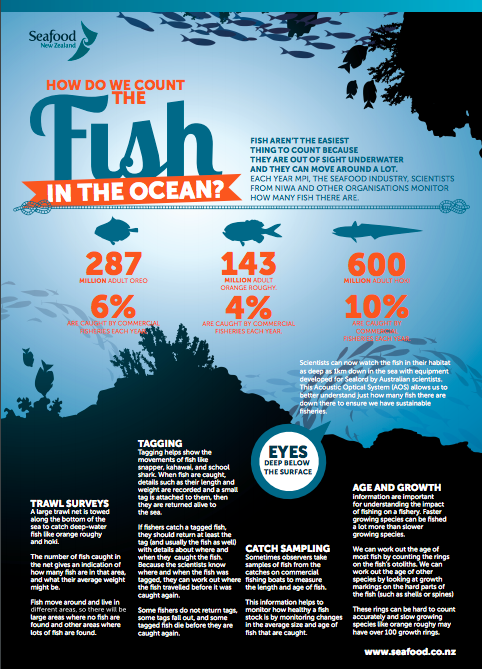
END OF THE LINE-TAKING NOTES- ANSWER QUESTIONS
SO FAR:
1. KEY CONCEPTS- WAI AND KAI SLIDES
2. NEEDS/WANTS
3. GOODS/SERVICES
4. RIGHTS AND RESPONSIBILITIES
5. WHY WE BUY?
-
Global Studies Learning Intention
We are EXPLORING what are rights and responsibilities are and connecting these to our identity as consumers
We are EXPLORING wants and needs and classifying these into essential and non-essential. We are collaborating with others to develop of shared understanding
Global Success Criteria
Identifying key concepts
Observing the importance of being responsible in order to respect people rights
Identifying and describing the rights and responsibilities of consumers and producers
Define overfishing
Identify the ways by which overfishing can be mitigated
making connections between the process of trash disposal from our house to the ocean
Describe some environmental problems created by our consumer world
categorising impacts in the water due to our consumerism
Describe the problems overfishing creates
describe the process of extraction through sale, use and disposal, all the stuff in our lives affects communities at home and abroad
Describe how the Consumer Guarantees Act and the Fair Trading Act protect the consumer
making connections between the process of trash disposal from our house to the ocean
Delineate why overfishing has occurredReflecting future economic and environmental strategies
-
Kia ora. Did you get out on the water during the long weekend? Perhaps you went fishing? If you could give some advice to recreational fishers what would it be? What about commercial fishers? Wai or Kai not?
Success Criteria: I can/have...
- Both consumers and retailers have rights and responsibilities
- Consumer protection laws and regulations cover goods and services purchased in New Zealand.
Achievement Objectives
Understand how producers and consumers exercise their rights and meet their responsibilities.
Learning outcomes:
Students will explore consumer protection in an authentic context.
Key concepts:- Rights
- Responsibilities
- Laws and regulation
- Consumer protection
Studies Learning Intention
We are EXPLORING what are rights and responsibilities are and connecting these to our identity as consumers
We are EXPLORING wants and needs and classifying these into essential and non-essential. We are collaborating with others to develop of shared understanding
Global Success Criteria
Identifying key concepts
Observing the importance of being responsible in order to respect people rights
Identifying and describing the rights and responsibilities of consumers and producers
making connections between the process of trash disposal from our house to the ocean
Describe some environmental problems created by our consumer world
categorising impacts in the water due to our consumerism
describe the process of extraction through sale, use and disposal, all the stuff in our lives affects communities at home and abroad
Describe how the Consumer Guarantees Act and the Fair Trading Act protect the consumer
making connections between the process of trash disposal from our house to the ocean
Reflecting future economic and environmental strategies
FOCUS / ARONGA learning intentions:
- We are Focusing on how our choices as consumers are creating the problem of overfishing
- We are FOCUSING on ways by which overfishing can be mitigated
-
Global and Science
You will deliver an oral presentation(TED Talk), (this could live or prerecorded) that explains the issue your static image addresses
You may use cue cards, but should not be reading off your document.
Your presentation should be a minimum of 2 minutes and a maximum of 5 - focus on what you need to say
Your oral presentation must include:
What the problem is and why this reflects the needs and wants of consumers and rights and responsibilities of producers.
The current legislation as it applies to New Zealand
The impact of commercial fishing on the environment and society of New Zealand
Advice for consumers when purchasing fish and/or for recreational fishers
Your TED talk should reflect the scientific and legal terms, language and concepts we have covered in class. Your TED talk will refer to your static image and explain the visual elements you have used to support your ideas.
YEAR 8
Student shows an understanding of the rights and responsibilities of producers and consumers
Criteria
WORKING TOWARDS Curriculum expectation
Working AT curriculum expectation
Working ABOVE curriculum expectation
Working BEYOND curriculum expectation
Producers and Consumers Responsibility
You have identified the legislation that governs producer and consumer rights and responsibilities in New Zealand fish industry
You have described the legislation that governs producer and consumer rights and responsibilities in New Zealand fish industry
You have provided a detailed description of the legislation that governs producer and consumer rights and responsibilities in New Zealand fish industry
You have explained the legislation that governs producer and consumer rights and responsibilities in New Zealand fish industry
Impact/Risk
Criteria shared with Science
You have identified impacts that consumers/ producer shave on the marine life
You have identified a range of impacts consumers/ producers have on the marine life
You have described a range of risks and impacts consumers/producers have on the marine life
You have described a range of risks and impacts consumers/ producers have on the marine life
Time management
You have yet to complete and submit your assessment
You have submitted your assessment late
You have submitted your assessment by the due date
You have submitted your assessment by the due date
Overall
WORKING TOWARDS Curriculum expectation
Working AT curriculum expectation
Working ABOVE curriculum expectation
Working BEYOND curriculum expectation
-
This is the last week before your TED TALK.
Checkpoint 1 and 2 are due on Tuesday
What the problem is and why this reflects the needs and wants of consumers and rights and responsibilities of producers.
The current legislation as it applies to New Zealand
Student shows an understanding of the rights and responsibilities of producers and consumers
Criteria
WORKING TOWARDS Curriculum expectation
Working AT curriculum expectation
Working ABOVE curriculum expectation
Working BEYOND curriculum expectation
Producers and Consumers Responsibility
You have identified the legislation that governs producer and consumer rights and responsibilities in New Zealand fish industry
You have described the legislation that governs producer and consumer rights and responsibilities in New Zealand fish industry
You have provided a detailed description of the legislation that governs producer and consumer rights and responsibilities in New Zealand fish industry
You have explained the legislation that governs producer and consumer rights and responsibilities in New Zealand fish industry
Impact/Risk
Criteria shared with Science
You have identified impacts that consumers/ producer have on the marine life
You have identified a range of impacts consumers/ producers have on the marine life
You have described a range of risks and impacts consumers/producers have on the marine life
You have described a range of risks and impacts consumers/ producers have on the marine life
Time management
You have yet to complete and submit your assessment
You have submitted your assessment late
You have submitted your assessment by the due date
You have submitted your assessment by the due date
Overall
WORKING TOWARDS Curriculum expectation
Working AT curriculum expectation
Working ABOVE curriculum expectation
Working BEYOND curriculum expectation
-
Kua takoto te Mānuka.
The leaves of the Manuka tree have been laid down (a challenge has been laid down or there is a challenge ahead of you).
Kia ora. I really enjoyed listening to your TED Talk presentations last week. This week, we are going to continue our exploration of consumer rights in New Zealand, who knows what Herman will do next (and how Auntie will help him understand his rights under New Zealand Consumer legislation.)
Success Criteria: I can/have...
- Both consumers and retailers have rights and responsibilities
- Consumer protection laws and regulations cover goods and services purchased in New Zealand.
Achievement Objectives
Understand how producers and consumers exercise their rights and meet their responsibilities.
Learning outcomes:
Students will explore consumer protection in an authentic context.
Key concepts:- Rights
- Responsibilities
- Laws and regulation
- Consumer protection
Studies Learning Intention
We are EXPLORING what are rights and responsibilities are and connecting these to our identity as consumers
We are EXPLORING wants and needs and classifying these into essential and non-essential. We are collaborating with others to develop of shared understanding
Global Success Criteria
Identifying key concepts
Observing the importance of being responsible in order to respect people rights
Identifying and describing the rights and responsibilities of consumers and producers
making connections between the process of trash disposal from our house to the ocean
Describe some environmental problems created by our consumer world
categorising impacts in the water due to our consumerism
describe the process of extraction through sale, use and disposal, all the stuff in our lives affects communities at home and abroad
Describe how the Consumer Guarantees Act and the Fair Trading Act protect the consumer
making connections between the process of trash disposal from our house to the ocean
Reflecting future economic and environmental strategies
Activities:
- Watch video for Consumer Rights - Unit 10
- Complete activities on google classroom
Homework:
-
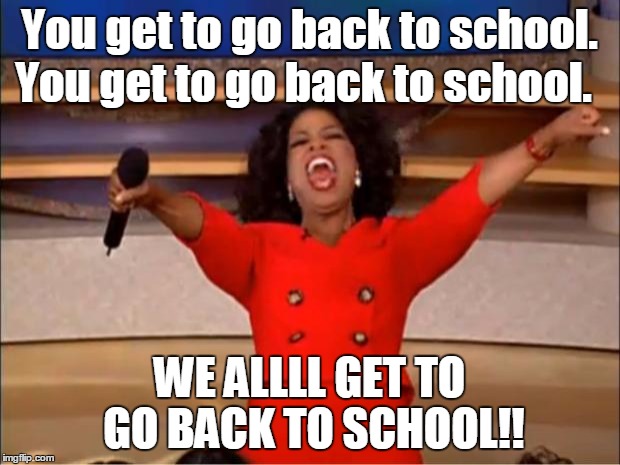 GO TO THIS WEBSITE TO DO THE ACTIVITY
GO TO THIS WEBSITE TO DO THE ACTIVITYHe rā whatiwhati kō.
A day of hardwork.
Kia ora. I hope you all had a lovely break and got out and about. What a change it was to be able to leave the house during the term break. Cast your mind back to the last term break and it was so very different. We have a busy term ahead of us. Will will mark the last of our Consumer Rights units (and try and get that last Kahoot squeezed in somewhere as well). We need to start work on our new context "Gaming for Learning". What do you think this will involve?
Achievement Objective: Understand how exploration and innovation create opportunities and challenges for people, places, and environments
Activities:
- Brainstorm (Categorise) New Zealand Innovations
- Select an invention/innovation for mini research
- Create a poster that informs of your chosen innovation/invention including who was involved, why it was needed and how it is used.
Homework:
Write here...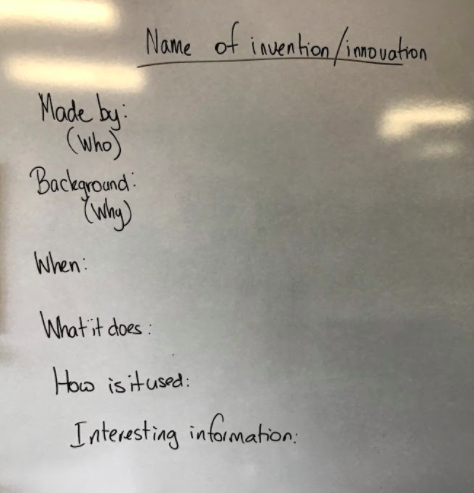
https://media.newzealand.com/en/story-ideas/great-kiwi-inventions/
https://anyquestions.govt.nz/many_answers/inventors-and-inventions-new-zealandhttps://www.tourradar.com/days-to-come/new-zealand-inventions/
EXPLORE / TŪHURA learning intentions:
- We are EXPLORING how the historical context of an invention influences the discoveryWe are EXPLORING the term Chronology and HistoryWe are EXPLORING Roman numerals
-
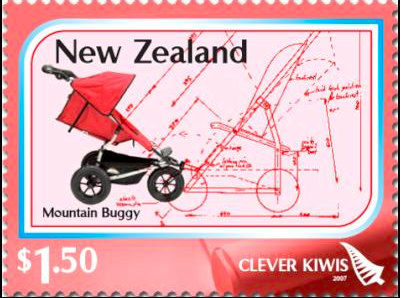
He mahi te āta noho, e kī ana te wheke
It is the octopus who says, “sitting is working”.
Kia ora. Well done on completing the cross country last week. It wasn't the best day for it but it was awesome to see you all trying your best. Last week we started looking at inventions and innovations in New Zealand. You completed a mini research project on a chosen invention and presented this to your group. This week, we are going to create a timeline of New Zealand inventions - and write a brief description of the invention at each point. I want you to start thinking about why an invention happens. What problem is trying to be solved? What opportunity has been presented?
Achievement Objective: Understand how exploration and innovation create opportunities and challenges for people, places, and environments
Success Criteria: I can/have...
- Identify some challenges that have led to inventions
- Describe opportunities created by inventions
- Discuss the difference between invention and innovation
Activities:
- Complete timeline activity (Google classroom)
- Write a brief paragraph describing each invention on the time line
- Brainstorm innovation and invention
- Create a Venn diagram using brainstorm
- Write a paragraph about the nature of invention and innovation
INVENTORS AND INVENTIONS
https://digitalnz.org/stories/57ed83d4125757166700282eSeven defining characteristics of being a “kiwi” AKA New Zealander
Story: Inventions, patents and trademarks
https://teara.govt.nz/en/inventions-patents-and-trademarks/page-1
EXPLORE / TŪHURA learning intentions:
- We are EXPLORING how the historical context of an invention influences the discovery
- We are EXPLORING the term Chronology and History
- We are EXPLORING Roman numerals
-
Continuity and Change – Students learn about past events, experiences, and actions and the changing ways in which these have been interpreted over time. This helps them to understand the past and the present and to imagine possible futures.
Place and Environment – Students learn about how people perceive, represent, interpret, and interact with places and environments. They come to understand the relationships that exist between people and the environment.

Achievement Objectives:
- Understand how exploration and innovation create opportunities and challenges for people, places, and environments.
- Understand that events have causes and effects.
Global Studies Learning Intention
We are EXPLORING how the historical context of an invention influences the discovery
We are EXPLORING the term Chronology and History
We are EXPLORING Roman numerals
Global Success Criteria
I can identify different stages in History
I can identify which history period my explorer come from
I can list times and dates into chronological order
I can see that the timeline is a chronology of dates and events
I can make centuries from a date
I can convert a century into a roman number
I can reflect how important is the historical period for the advances in technology and exploration
I can identify roman numbers
I can describe how a timeline is useful to give an overview of a historical period
I can explain why is an important timeline in history
I can define Chronology
I can describe the differences between Bc-Ad-CE and BCE
Google classroom
1. How has technology changed our lives
2. Word association
3. Inventions that changed the world
EXPLORE / TŪHURA learning intentions:
- We are EXPLORING how the historical context of an invention influences the discovery
- We are EXPLORING the term Chronology and History
- We are EXPLORING Roman numerals
-
Continuity and Change – Students learn about past events, experiences, and actions and the changing ways in which these have been interpreted over time. This helps them to understand the past and the present and to imagine possible futures.
Place and Environment – Students learn about how people perceive, represent, interpret, and interact with places and environments. They come to understand the relationships that exist between people and the environment.
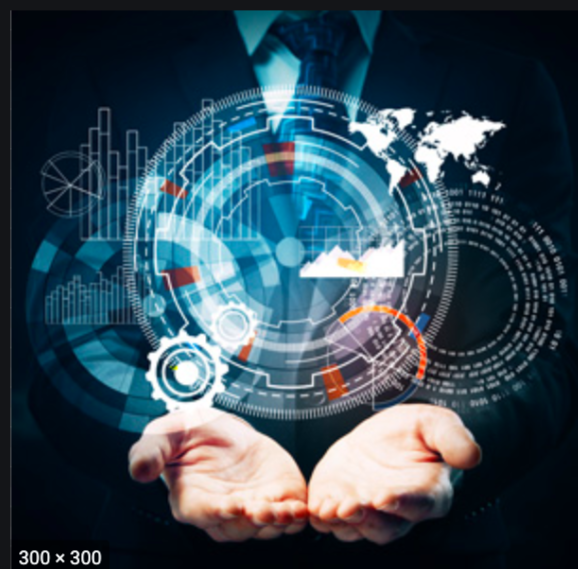
Achievement Objectives:
- Understand how exploration and innovation create opportunities and challenges for people, places, and environments.
- Understand that events have causes and effects.
Global Studies Learning Intention
We are Focussing on understanding the impacts of technology and can carefully evaluate the importance of it aspects to them and their lives
Global Success Criteria
I can identify the impacts of technology in our ives
I can see the development of technology from the indsutrial revolution
I can make questions related to technologicas changes
I can reflect on the differences between my generation and older generations.
I can evalute the importance of the impact of the technology in our lives
I can describe how why some aspects of culture must be handed down to be retained or otherwise lost
I can explain how NZ’s isolation led to the idea of “Kiwi ingenuity” and why this has been important for our national identity (on field trip to MOTAT).
I can explain rights and responsibilities associated with aspects of technology eg cell phones and the internet.
Google classroom
1. How has technology changed our lives
2. Word association
3. Invention that changed the world
4. Race who is the fastest
FOCUS / ARONGA learning intentions:
- We are FOCUSING on understanding the impacts of technology and can carefully evaluate the importance of it aspects to them and their lives
- We are FOCUSING on New Zealand technology and describing the process of design of either a new invention or an innovation on existing technology
-
This week we are focusing on the activity of AN EVOLUTION OF AN IDEA
In this activity, you need to find out an innovation made in our century.
Then you need to present:
1. What is innovation?
2. Year of innovation
3. Why is innovation? Describe the characteristics of an innovation (follow the key terms)
4. Benefits of the innovation
5. What was before the innovation
6. HIstory: when was the INVENTION CREATED
FOCUS / ARONGA learning intentions:
- We are FOCUSING on understanding the impacts of technology and can carefully evaluate the importance of it aspects to them and their lives
- We are FOCUSING on New Zealand technology and describing the process of design of either a new invention or an innovation on existing technology
-
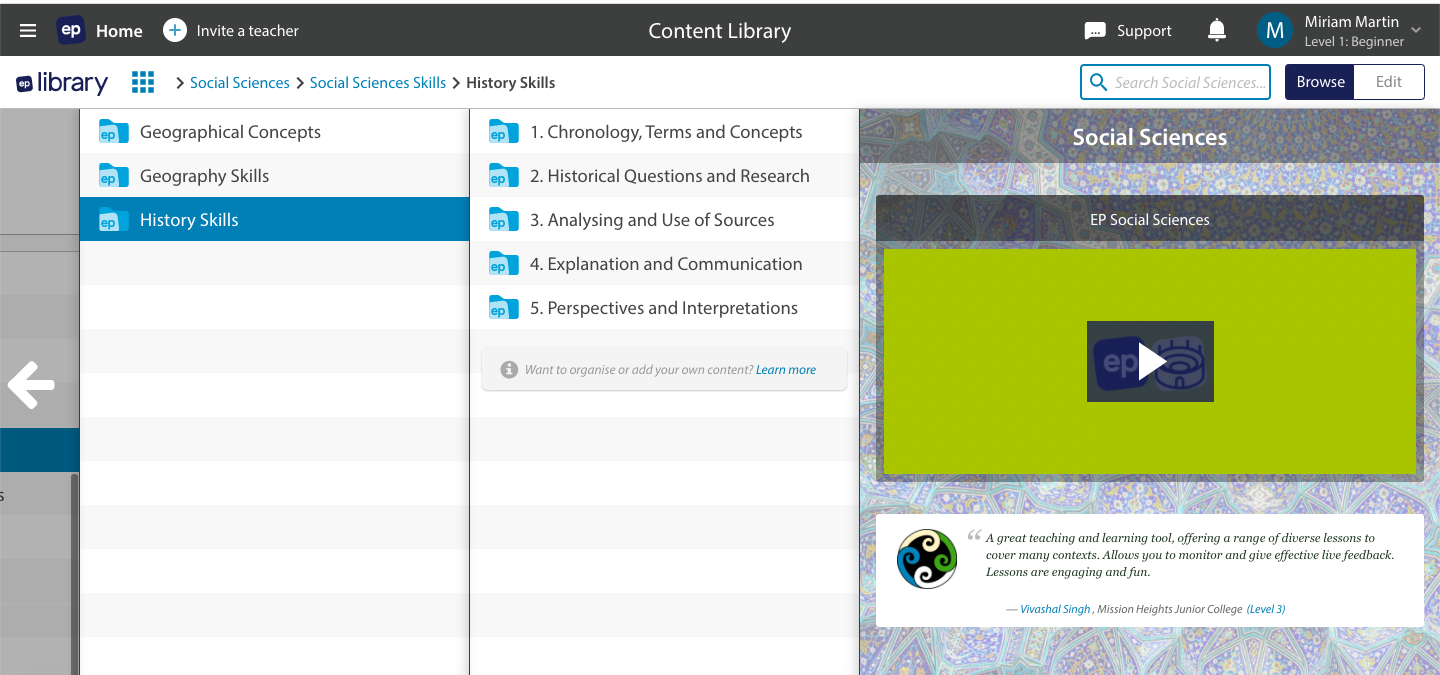
FOCUS / ARONGA learning intentions:
- We are FOCUSING on understanding the impacts of technology and can carefully evaluate the importance of it aspects to them and their lives
- We are FOCUSING on New Zealand technology and describing the process of design of either a new invention or an innovation on existing technology
-
Welcome back to our last term of the year. For this one, we will look at the cultural nature of scientific research. How people interpret science in different ways based on their social environments.
Science is a collaborative effort among all of the different cultures and countries of the world.
Big Idea: OUT OF THIS WORLD
Learning Intentions: We are learning to (WALT)...
- Explore famous scientists, their theories, places of origin, and their culture
- Document scientific viewpoints of famous scientists throughout history
- Know about some of the major discoveries in astronomy and space exploration
- Understand how these were made
- Be able to put these in order and explain the reasons for this
- Discuss geographical region, culture, gender, and other factors affecting scientific theories and discoveries
Achievement Objectives:
- Understand how exploration and innovation create opportunities and challenges for people, places, and environments.
Success Criteria: I can/have...
- Identify the main explorers of the universe in history
- completed the Explore the Famous Scientists
- described the beginning of the wondering of the universe and why
Activities:
- https://www.nationalgeographic.com/science/space/universe/origins-of-the-universe/
- https://www.youtube.com/watch?v=epuoIYqIkBc
While you are watching the video, think about the processes of scientific inquiry and the nature of science
Use the handout, Famous Scientists and work in groups.
Place the scientists on the world map.
Discuss how science is an accumulated contribution of different scientists coming from different cultures throughout many periods.
- Images of Albert Einstein, Carolyn Shoemaker, and Abd AlRahman Al Sufi can be found at the following websites:
- Einstein: http://albert-einstein.org/
- Shoemaker: http://www.universetoday.com/html/articles/2001-1211a.html
- Sufi: http://www.sfusd.k12.ca.us/schwww/sch618/ScienceMath/Science2.html
Homework:
Complete a report of a scientist from your selection.https://www.youtube.com/watch?v=wNDGgL73ihY
EXPLORE / TŪHURA learning intentions:
- We are EXPLORING the developments used to observe or explore space to illustrate how our knowledge of the universe has evolved over time.
-
Big Idea: OUT OF THIS WORLD
Learning Intentions: We are learning to (WALT)...
- Explore famous scientists, their theories, places of origin, and their culture
- Document scientific viewpoints of famous scientists throughout history
- Know about some of the major discoveries in astronomy and space exploration
- Understand how these were made
- Be able to put these in order and explain the reasons for this
- Discuss geographical region, culture, gender, and other factors affecting scientific theories and discoveries
Achievement Objectives:
- Understand how exploration and innovation create opportunities and challenges for people, places, and environments.
Success Criteria: I can/have...
- Identify the main explorers of the universe in history
- completed the Explore the Famous Scientists
- described the beginning of the wondering of the universe and why
Activities:
- https://www.nationalgeographic.com/science/space/universe/origins-of-the-universe/
- https://www.youtube.com/watch?v=epuoIYqIkBc
While you are watching the video, think about the processes of scientific inquiry and the nature of science
Use the handout, Famous Scientists and work in groups.
Place the scientists on the world map.
Discuss how science is an accumulated contribution of different scientists coming from different cultures throughout many periods.
- Images of Albert Einstein, Carolyn Shoemaker, and Abd AlRahman Al Sufi can be found at the following websites:
- Einstein: http://albert-einstein.org/
- Shoemaker: http://www.universetoday.com/html/articles/2001-1211a.html
- Sufi: http://www.sfusd.k12.ca.us/schwww/sch618/ScienceMath/Science2.html
Homework:
Complete a report of a scientist from your selection.https://www.youtube.com/watch?v=wNDGgL73ihY
EXPLORE / TŪHURA learning intentions:
- We are EXPLORING the developments used to observe or explore space to illustrate how our knowledge of the universe has evolved over time.
-
Big Idea: OUT OF THIS WORLD
Learning Intentions: We are learning to (WALT)...
- Explore famous scientists, their theories, places of origin, and their culture
- Document scientific viewpoints of famous scientists throughout history
- Know about some of the major discoveries in astronomy and space exploration
- Understand how these were made
- Be able to put these in order and explain the reasons for this
- Discuss geographical region, culture, gender, and other factors affecting scientific theories and discoveries
Achievement Objectives:
- Understand how exploration and innovation create opportunities and challenges for people, places, and environments.
Success Criteria: I can/have...
- Identify the main explorers of the universe in history
- completed the Explore the Famous Scientists
- described the beginning of the wondering of the universe and why
Activities:
- 1. Presentation in your groups about your chosen area of interest.
- 2. Know about the key players in the history of astronomy
EXPLORE / TŪHURA learning intentions:
- We are EXPLORING the developments used to observe or explore space to illustrate how our knowledge of the universe has evolved over time.
-
We are continuing this week finishing our posters for the Famous Astronomers
Learning Intention: We are learning to find relevant information from a variety of texts and present it in our own words to create an informative poster.
Task:
Famous Astronomer Assignment
You have been introduced to a number of famous astronomers and scientists from history. These people have made huge discoveries about the planet and universe we live in. Your mission is to choose one person from the list and design an informative poster. It should tell the audience reading it that the following information
What Discovery did that person make?
What were the most important years of their work and findings and what were they?
What culture-historical era was that person from?
Why were they curious?
Why is it important about the thing they discovered?
What were the challenges they faced?
Add a timeline to your poster of the important findings of this scientist/astronomer
EXPLORE / TŪHURA learning intentions:
- We are EXPLORING the developments used to observe or explore space to illustrate how our knowledge of the universe has evolved over time.
-
Kia ora. Welcome to week 5. Last week we watch the movie "Hidden Figures" and saw the time and place that space race occurred in. This was a time of massive upheaval for America. We are looking at how Innovation and Exploration create opportunities and challenges for people, places, and environments. What challenges and opportunities did you see in the film? Were these positive or negative for the environment? What else was happening around the world during this time and how did this impact on the mood/will/focus of people?
Success Criteria: I can/have...
- Detail innovations and inventions associated with the "Space Race"
- Identify challenges and opportunities in 1960s USA
- Describe impact of actions on the environment and place
Activities:
- In small groups (3), create a slideshow that backgrounds the innovations and inventions of the space race (5 slides)
- Using Hidden Figures to inform your understanding, list 5 challenges and 5 opportunities linked to the space race (2 slides)
- Create a Venn diagram that shows the impact on people, place and environment (1 slide)- your venn diagram will have 3 interlinking circles

Homework:
Write here...EXPLORE / TŪHURA learning intentions:
- We are EXPLORING the developments used to observe or explore space to illustrate how our knowledge of the universe has evolved over time.
-

Kia hora te marino, kia whakapapa pounamu te moana, kia tere te kārohirohi i mua i tō huarahi.
May peace be widespread, may the sea glisten like greenstone, and may the shimmer of light guide you on your way.
Kia ora. We have a very busy week this week - you have the bike riding course and a teacher only day on Thursday, so we will have to really knuckle down to get our work completed.
Success Criteria: I can/have...
- Detail innovations and inventions associated with the "Space Race"
- Identify challenges and opportunities in 1960s USA
- Describe impact of actions on the environment and place
Activities:
In small groups (3), create a slideshow that backgrounds the innovations and inventions of the space race (5 slides)
Using Hidden Figures to inform your understanding, list 5 challenges and 5 opportunities linked to the space race (2 slides)
Create a Venn diagram that shows the impact on people, place and enviroment (1 slide)- your venn diagram will have 3 interlinking circles
Homework:
Write here...EXPLORE / TŪHURA learning intentions:
- We are EXPLORING the developments used to observe or explore space to illustrate how our knowledge of the universe has evolved over time.
